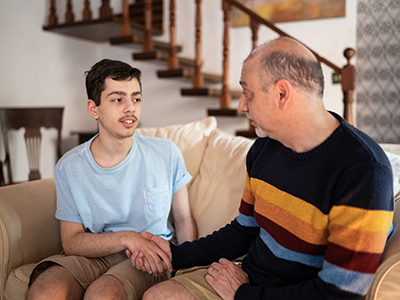During summer, the change in usual routines can also lead to increased safety challenges and risky behaviors for some children with autism. Wandering, also called “elopement,” is a common challenge for many children and adults on the spectrum, as well as for their families and caregivers who are trying to keep them safe. Families are understandably frightened when an autistic child wanders off, and it’s often unexpected the first time it happens. Increased access to water activities increases the risks. Fortunately, there are many resources and strategies families can use to help keep their children safe.
- Use simple safety measures. If your child is prone to wandering at home, considering installing interior locks high on doors leading outside, so that your child cannot open the door. If you have an alarm system, see if you can set it to sound when a door is opened from the inside.
- Have a plan for walks and bike rides outside of the home. Be sure to use child locks on car doors so they can’t open them while the car is moving. If your child tends to wander in public, teach rules about holding hands but engage everyone in your group to help monitor. It’s also a good idea to dress your child in bright colors, so you can easily spot them outdoors or in crowded places.
- Identification bracelets are also a helpful tool. Soft, rubber bracelets can be purchased easily online and customized with your child’s name, key medical information, and contact information. This is a particularly useful tool for children on the spectrum, who may struggle to communicate in stressful situations, even if they often show good language skills in daily circumstances.
- If you are joining family and/or friends, communicate your child’s risks to them and engage them in keeping the activity safe for your child. Assign adults or mature adolescents to supervise group members who need extra support. The individual who is supervising must communicate clearly when they are handing over the responsibility to someone else.
- Spot the patterns. If your child is prone to persistent wandering or elopement, try to take note of the patterns in your child’s behavior to be better prepared for problems. If your child works with a behavioral therapist or psychologist, consult their provider for help understanding their behavior patterns and designing a plan to keep them safe using strategies that have been helpful in other settings, such as the school.
- Build your safety net. Alert neighbors to be on the lookout for children who persistently manage to wander off, providing your contact information and simple directions for how to approach and speak with your child and keep them safe until you arrive. Contact your local police department and ask if you can register your child with them. Introduce your child to local police officers and teach them how to safely approach an officer to ask for help, either by speaking or by showing an identification bracelet.
- Teach water safety. The most common way that children are seriously injured or killed due to wandering is by drowning. It is critical for all children to learn water safety skills. Create and reinforce rules about staying away from water unless an adult is present. Even individuals who know how to swim or are using flotation devices are at risk for drowning.
- Ensure gates to pools are locked and working properly (but recognize that this is not sufficient to deter a kid) and that toys are removed from the pool.
- Risks are present even when adults are present to supervise. Assign adults to supervise the pool, trading off every 15-30 minutes to help unsure focused supervision. Don’t assume safety in shallow water or because a child has a life jacket on. Adults who are supervising children who are not strong swimmers should ensure the child remains within “arm’s length.”
- Swim lessons are an important step to water safety. Contact your local recreation department to ask about adapted swimming classes, including programs designed to address the needs of individuals with ASD. There are also private agencies and swimming instructors in many areas who specialize in swimming instruction for children with disabilities.
 https://riseandshine.childrensnational.org/wp-content/uploads/2025/03/woman-being-mindful-feature.jpg
300
400
Danielle Robbins
https://riseandshine.childrensnational.org/wp-content/uploads/2017/11/childrens_riseandshine_logo.jpg
Danielle Robbins2025-03-19 16:47:262025-03-19 16:48:14Self-care for parents of children with autism: Avoiding burnout
https://riseandshine.childrensnational.org/wp-content/uploads/2025/03/woman-being-mindful-feature.jpg
300
400
Danielle Robbins
https://riseandshine.childrensnational.org/wp-content/uploads/2017/11/childrens_riseandshine_logo.jpg
Danielle Robbins2025-03-19 16:47:262025-03-19 16:48:14Self-care for parents of children with autism: Avoiding burnout





















Leave a Comment
Want to join the discussion?Feel free to contribute!